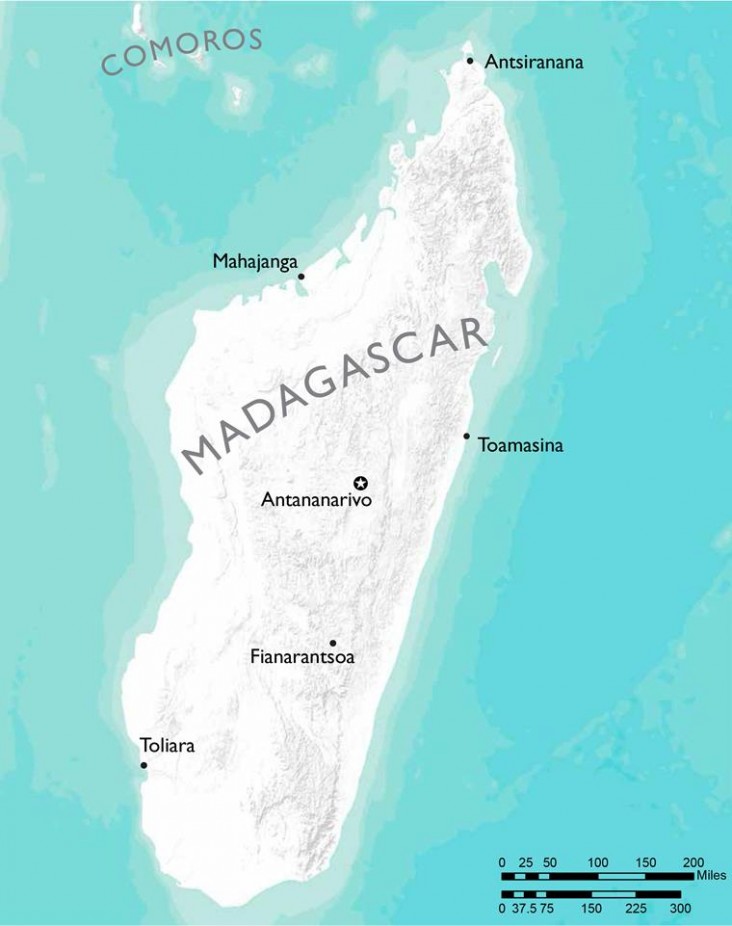- What We Do
- Agriculture and Food Security
- Democracy, Human Rights and Governance
- Economic Growth and Trade
- Education
- Ending Extreme Poverty
- Environment and Global Climate Change
- Gender Equality and Women's Empowerment
- Global Health
- Water and Sanitation
- Working in Crises and Conflict
- U.S. Global Development Lab

June 30, 2017
Food Security Situation
-
Populations in Madagascar are at risk for natural disasters—such as cyclones, floods, droughts, and locust infestations—that threaten food security. At the end of 2016, following three years of consecutive drought exacerbated by El Niño, almost 1 million people in Madagascar’s southern regions required humanitarian assistance, according to the UN. In March 2017, Cyclone Enawo made landfall in Madagascar, harming household food stores and livelihood activities. The USAID-funded Famine Early Warning Systems Network (FEWS NET) reports that the storm flooded fields and disrupted the cultivation of cash crops, such as vanilla, litchi, orange, banana, and breadfruit. The UN World Food Program (WFP), a partner of USAID’s Office of Food for Peace (FFP), responded to these crises, reaching over 740,000 drought-affected people in the south with food assistance, as well as 66,000 cyclone-affected people with food distributions as of April 2017. FFP’s NGO partners, Adventist Development and Relief Agency (ADRA) and Catholic Relief Services (CRS), have also provided emergency food and nutrition assistance to populations affected by the drought.
-
Poor rains in late 2016 and early 2017 hampered agricultural production in many parts of Madagascar. Although rainfall generally improved toward the end of the rainy season in March 2017, annual yields of rice and corn, main staple crops, will likely be below average. Near some areas with low production, food prices are currently higher than normal and may remain elevated in the coming months.
- FEWS NET expects that much of Madagascar will experience Minimal (IPC Phase 1) levels of food insecurity until September 2017.* Recognizing the improvement in the nation’s food security situation, WFP began emphasizing resilience building—in lieu of an emergency response—in June. However, high food prices, below-average crop yields, and diminished incomes will cause households residing in some of the nation’s coastal southern regions to experience Stressed (IPC Phase 2) levels of food insecurity until September 2017. Moreover, in some localized areas in southern Madagascar, erratic and inadequate rains have yielded meager harvests; people in these areas will require emergency food assistance once their household food stores are depleted.
Food Assistance Programs
- In FY 2017, FFP has committed approximately $8 million in emergency food assistance in Madagascar, providing over 6,000 metric tons of U.S. in-kind food aid and locally and regionally procured food.
- FFP also supports two five-year development projects in Madagascar, implemented by ADRA and CRS, in areas where chronic undernutrition levels are high. ADRA aims to improve the nutrition and health status of children under five and women of reproductive age, ensure vulnerable households can access enough food to meet their nutritional needs, and provide communities with the tools to prepare for and respond to disasters. Similarly, CRS seeks to prevent malnutrition and improve health among children under two and women, increase household incomes through enhanced agricultural practices, and strengthen community capacity to manage shocks. Together, FFP’s partners are reaching more than 620,000 people in Madagascar.
Food for Peace Contributions
Total Contributions:
| U.S. Dollars | Metric Tons | |
|---|---|---|
| Fiscal Year 2017 | $14.3 million | 7,480 MT |
| Fiscal Year 2016 | $46.6 million | 28,510 MT |
| Fiscal Year 2015 | $10.4 million | 10,460 MT |
Fiscal Year 2017 Contribution Breakdown:
| U.S. Dollars | Metric Tons | |
|---|---|---|
| Title II Development | $6.2 million | 1,300 MT |
| Title II Emergency | $5.3 million | 3,100 MT |
| Emergency Food Security Program (EFSP) | $2.7 million | 3,080 MT |
*The Integrated Food Security Phase Classification (IPC) is a standardized tool that aims to classify the severity and magnitude of food insecurity. The IPC scale, which is comparable across countries, ranges from Minimal—IPC I—to Famine—IPC 5.
Country Specific Guidance
- Madagascar Country Specific Information - FY 2014 RFA (PDF, 519 KB)







Comment
Make a general inquiry or suggest an improvement.